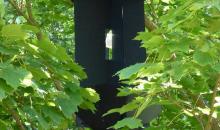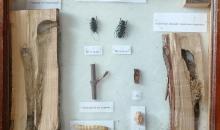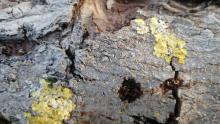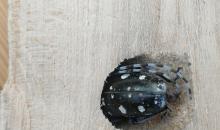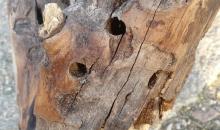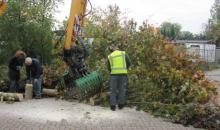Anoplophora glabripennis(ANOLGL)
Photos
For publication in journals, books or magazines, permission should be obtained from the original photographers with a copy to EPPO.

Ovipositing female of Anoplophora glabripennis.
Courtesy: Matteo Maspero, Fondazione Minoprio, Vertemate con Minoprio (IT).
Removal of the infested birch trees at Corbetta, Lombardia (IT).
Courtesy: Franck Hérard, European Biological Control Laboratory, Montferrier-sur-Lez (FR).
Feeding damage on twigs and petioles caused by adults of Anoplophora glabripennis.
Courtesy: Matteo Maspero, Fondazione Minoprio, Vertemate con Minoprio (IT).
Signs of predation of Anoplophora glabripennis by birds.
Courtesy: Franck Hérard, European Biological Control Laboratory, Montferrier-sur-Lez (FR).
Adult Anoplophora glabripennis.
Courtesy: Franck Hérard, European Biological Control Laboratory, Montferrier-sur-Lez (FR).
Larval galeries of Anoplophora glabripennis.
Courtesy: Franck Hérard, European Biological Control Laboratory, Montferrier-sur-Lez (FR).
Prothorax of Anoplophora glabripennis (left) and A. chinensis (right) larvae.
Courtesy: Franck Hérard, European Biological Control Laboratory, Montferrier-sur-Lez (FR).
Exit holes of Anoplophora glabripennis.
Courtesy: Franck Hérard, European Biological Control Laboratory, Montferrier-sur-Lez (FR).
Exit holes and oviposition pits of Anoplophora glabripennis on maple (Acer).
Courtesy: Matteo Maspero, Fondazione Minoprio, Vertemate con Minoprio (IT).
Callow (young) adult of Anoplophora glabripennis.
Courtesy: Franck Hérard, European Biological Control Laboratory, Montferrier-sur-Lez (FR).
Exit holes and oviposition pits of Anoplophora glabripennis on maple (Acer).
Courtesy: M. Maspero, Fondazione Minoprio, Como (IT).
Replanting Gingko at Corbetta, Lombardia (IT).
Courtesy: Plant Protection Service of Lombardia (IT).
Sap oozing from an oviposition pit of Anoplophora glabripennis.
Courtesy: M. Maspero, Fondazione Minoprio, Como (IT).
Full grown larva of Anoplophora glabripennis.
Courtesy: Franck Hérard, European Biological Control Laboratory, Montferrier-sur-Lez (FR).
Removal of the infested maple tree at Corbetta, Lombardia (IT).
Courtesy: Franck Hérard, European Biological Control Laboratory, Montferrier-sur-Lez (FR).
Medium size larva of Anoplophora glabripennis.
Courtesy: M. Maspero, Fondazione Minoprio, Como (IT).
Egg of Anoplophora glabripennis.
Courtesy: Franck Hérard, European Biological Control Laboratory, Montferrier-sur-Lez (FR).
The three infested silver birches (Betula pendula) at Corbetta, Lombardia (IT).
Courtesy: Franck Hérard, European Biological Control Laboratory, Montferrier-sur-Lez (FR).
Exit holes of Anoplophora glabripennis on maple (Acer).
Courtesy: Franck Hérard, European Biological Control Laboratory, Montferrier-sur-Lez (FR).
Feeding damage caused by adults of Anoplophora glabripennis.
Courtesy: Franck Hérard, European Biological Control Laboratory, Montferrier-sur-Lez (FR).
Young larva of Anoplophora glabripennis.
Courtesy: Franck Hérard, European Biological Control Laboratory, Montferrier-sur-Lez (FR).
Sentinel trees planted at Corbetta, Lombardia (IT).
Courtesy: Plant Protection Service of Lombardia (IT).
Frass extruded from larval tunnel of Anoplophora glabripennis through cracks in bark.
Courtesy: Matteo Maspero, Fondazione Minoprio, Vertemate con Minoprio (IT).
Medium size larva of Anoplophora glabripennis.
Courtesy: Matteo Maspero, Fondazione Minoprio, Vertemate con Minoprio (IT).
Oviposition slit of Anoplophora glabripennis on birch (Betula).
Courtesy: Matteo Maspero, Fondazione Minoprio, Vertemate con Minoprio (IT).
Removal of the infested birch trees at Corbetta, Lombardia (IT).
Courtesy: Franck Hérard, European Biological Control Laboratory, Montferrier-sur-Lez (FR).
Pupa of Anoplophora glabripennis in its pupal chamber.
Courtesy: Franck Hérard, European Biological Control Laboratory, Montferrier-sur-Lez (FR
Elytrae of Anoplophora chinensis (left) and A. glabripennis (right).
Courtesy: M. Maspero, Fondazione Minoprio, Como (IT).
Replanting Liquidambar at Corbetta, Lombardia (IT).
Courtesy: Plant Protection Service of Lombardia (IT).
Oviposition pit of Anoplophora glabripennis on birch (Betula).
Courtesy: Franck Hérard, European Biological Control Laboratory, Montferrier-sur-Lez (FR).
Hollow bark.
Courtesy: Franck Hérard, European Biological Control Laboratory, Montferrier-sur-Lez (FR).
Branch dieback caused by Anoplophora glabripennis.
Courtesy: M. Maspero, Fondazione Minoprio, Como (IT).
Frass in the fork of branches.
Courtesy: Matteo Maspero, Fondazione Minoprio, Vertemate con Minoprio (IT).
Larval galery (L2) in the cambium layer.
Courtesy: Franck Hérard, European Biological Control Laboratory, Montferrier-sur-Lez (FR).
Ovipositing female of Anoplophora glabripennis.
Courtesy: Franck Hérard, European Biological Control Laboratory, Montferrier-sur-Lez (FR).
Infested maple tree (Acer pseudoplatanus) at Corbetta, Lombardia (IT).
Courtesy: Franck Hérard, European Biological Control Laboratory, Montferrier-sur-Lez (FR).
Inspecting trees for Anoplophora glabripennis symptoms
Courtesy: Wietse den Hartog NVWA (NPPO the Netherlands)
Inspecting trees for Anoplophora glabripennis symptoms
Courtesy: Wietse den Hartog NVWA (NPPO the Netherlands)
Exit holes and damage of Anoplophora glabripennis
Courtesy: Wietse den Hartog NVWA (NPPO the Netherlands)
Pupal chamber with adult of Anoplophora glabripennis
Courtesy: Wietse den Hartog NVWA (NPPO the Netherlands)
Pupal chamber with adult of Anoplophora glabripennis
Courtesy: Wietse den Hartog NVWA (NPPO the Netherlands)
X-ray CT-scan of Acer wood affected by Anoplophora glabripennis
Courtesy: Wietse den Hartog NVWA (NPPO the Netherlands)
Acer wood affected by Anoplophora glabripennis
Courtesy: Wietse den Hartog NVWA (NPPO the Netherlands)
Acer wood affected by Anoplophora glabripennis in X-ray CT-scanner
Courtesy: Wietse den Hartog NVWA (NPPO the Netherlands)
X-ray CT-scan of Acer wood affected by Anoplophora glabripennis
Courtesy: Wietse den Hartog NVWA (NPPO the Netherlands)
X-ray CT-scan of Acer wood affected by Anoplophora glabripennis
Courtesy: Wietse den Hartog NVWA (NPPO the Netherlands)































